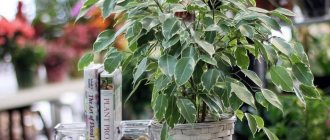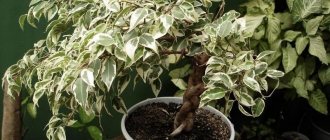This feature gave the plant its second name - ficus banyan. The largest banyan tree grows in the Indian Botanical Garden and occupies about one and a half hectares of area. Cultivated indoor specimens reach a height of no more than 1.5-3 m. They have a high development rate - approximately 60-100 cm per year, and are also perennials.
Other ficus:
| Ficus rubber - care and reproduction |
| Ficus microcarpa - care |
| Ficus lyreformes |
| Ficus sacred |
| They have a high development rate - approximately 60-100 cm per year |
| At home, ficus does not bloom. |
| The plant is easy to grow. Suitable for a beginner. |
| Perennial. |
Useful properties of ficus bengal
Ficus not only decorates the interior of the house. This plant is known for its powerful filtering properties, thanks to which the indoor air is purified from harmful impurities such as benzene, ammonia, phenol, and formaldehyde.
In addition, the tree enriches the environment with active substances that have a beneficial effect on human well-being. Ficus is also used in the manufacture of some cosmetics, medications in the form of ointments and tinctures for the treatment of many diseases.
How to care?
Bengal ficuses are considered unpretentious representatives of the flora with an easy-going character, however, flower growers need to follow basic rules for caring for the tree. If this is not done, the luxurious symbol of life will turn into a sick and capricious creature that sheds its leaves.
Home care rules:
- do not forget to water the ficus in a timely manner;
- ensure temperature conditions;
- make sure that the air is not too dry;
- the tree should grow in a bright room;
- be sure to replant the ficus as necessary;
- Fertilize and feed regularly.
Compliance with all the rules will ensure the correct development of your green pet, which will delight you with its beauty for a long time.
Ficus bengal: care at home. Briefly
Ficus bengal grows easily and without problems at home with the following maintenance nuances:
| Temperature | Above 18 ºС in summer, in winter – not lower than 17 ºС. |
| Air humidity | Average – about 50-60%. |
| Lighting | Intense sunny, south and south-east windows. |
| Watering | Moderate, regular, without stagnation of liquid in the soil. |
| Soil for ficus bengal | Nutritious, slightly acidic, with a neutral pH. |
| Feeding and fertilizer | Alternating mineral and organic nutritional compositions. |
| Transplanting ficus bengal | It is carried out once every 2-3 years, at the end of winter. |
| Reproduction | Layerings, apical cuttings. |
| Features of cultivation | Afraid of drafts. Annual crown formation is necessary. From time to time the tree should be turned to the other side towards the sun. The milky sap of ficus can be dangerous for people suffering from bronchial asthma; it is better to work with the plant with gloves. |
Origin of the plant
Ficus benghalensis belongs to the mulberry family. It comes from the tropical jungles of India, Thailand, Burma, and southern China.
Its second name - banyan - means a form of life when one plant, thanks to the special abilities of its aerial roots and shoots, takes on the appearance of an entire grove.
Numerous trunks in such a “forest” are just parts of one Ficus Bengal ecosystem.
Over time, it will grow in breadth and height, capturing vast territories.
Growth continues endlessly, and more and more new roots, rushing from the upper shoots to the ground, take root in the soil and give rise to fresh “trees”.
Of course, it is almost impossible to repeat this miracle at home.
Those who nevertheless decide on such a feat will have to be patient and have a large room in which it will be necessary to create a tropical atmosphere.
However, many enthusiasts successfully grow tabletop “banyan trees” in their homes, which are often called bonsai culture.
REFERENCE: “Bonsai” in Japanese means “tree on a platter” and is a miniature and always living copy of a tree.
What is "banyan"?
The authors of this term are Europeans. When Portuguese and English travelers in the XV-XVI centuries. described the wonders of the fabulous country of India they discovered, they drew attention to the unusual trees that served as a kind of roof for the local bazaars and other mass gatherings of local residents.
Of course, under the shadow of such a giant, the word “baniya” was heard very often, which in Gujarati means “merchant, trader.”
Without thinking twice, the Europeans “awarded” the tree itself with this word.
This is how the Bengal ficus became a “merchant tree”.
If you are interested in tree-like ficuses, we recommend that you familiarize yourself with the rules for growing the following varieties: Lyrata, Blunt, Carica, Ginseng, Eden, Amstel King, Large-leaved, Retuza, Small-leaved and Benedicta.
Caring for Bengal ficus at home. Details
Bloom
When grown indoors, the indoor ficus bengal does not bloom. But in greenhouse conditions, there are specimens with syconia - round orangeish seed fruits that are of no decorative value.
Temperature
The optimal maintenance temperature for ficus is 18-22°C, both in summer and winter. Ficus is a tropical tree, so a slight increase in temperature will not harm the plant if a sufficient level of humidity is maintained.
Spraying
Caring for ficus bengal at home involves constantly providing the plant with the required degree of humidity. This can be achieved in several ways:
- spraying once a week, especially in hot weather or in winter if the tree is located near heating systems;
- moisturizing ficus leaves by regularly wiping off dust, or by rinsing in the shower;
- placing the flower in a bowl with wet expanded clay.
It is advisable to spray and otherwise moisten the ficus with warm, softened water.
Lighting
The Bengal ficus prefers well-lit rooms, but also grows well in rooms with diffused light. If partial shade is created on the windowsill with a ficus, it is recommended to periodically turn the plant with different sides to the sun, which will contribute to the uniform development of the crown.
In winter, sunlight can be replaced by artificial lighting.
Watering ficus bengal
Watering is carried out no more than two or three times a week, as soon as the surface layer of soil dries out by about 2 cm. Stagnation of moisture should be avoided, so excess water is always poured out of the pan. In winter, the plant is watered much less frequently - once every 7-10 days.
Pot for ficus bengal
As a rule, there are no special requirements for a ficus pot. It is enough to choose a container of normal proportions suitable for the size of the plant.
A vessel that is too large will cause moisture stagnation and, as a result, rot.
Priming
Ficus Bengal at home is planted in the following soil composition:
- turf (2 parts)
- leaf soil (2 parts)
- sand (1 part)
It can also be a slightly acidic universal substrate.
Feeding and fertilizer
Ficus feeding is carried out all year round, with the exception of the winter period. It is recommended to alternate mineral and organic fertilizers, feeding the plant once every 14 days. In winter, only ficus plants growing in inert soil are fertilized.
Transfer
Replanting the ficus bengal is carried out as soon as the earthen ball of the plant is completely entwined with roots, protruding from the pot.
For mature trees, the period between transplants is 2-4 years. During the replanting procedure, the roots are lightly shaken off the old substrate, placed in a larger container and covered with prepared soil without deepening the root collar. Immediately after transplantation, you should not expect rapid growth of the ficus. It will resume its development only in a month.
How to prune a Bengal ficus
Pruning of the Bengal ficus is necessary to slow down the growth in height of the main branch, the trunk, since the plant tends to sharply stretch out without growing lateral branches. All formative manipulations should be carried out during the active growth phase of the tree, that is, in spring or early summer.
When it is noticeable that the plant has begun to grow, the branch is cut at the required height with pruning shears and, after washing off the milky juice, it is sprinkled with charcoal. This procedure will give an impetus to the awakening of other “dormant” buds and after a while you can expect the tree to branch.
Rest period
The ficus bengal plant at home does not need a well-defined dormant period. Only certain varieties of ficus can “show” the need for rest due to reduced light and temperature.
How to choose?
In order for a crop to grow and develop well indoors, it is necessary to choose the plant wisely. You should adhere to the following rules.
- Choose a young plant.
- Inspect the tree for damage and shake lightly. If the leaves fall off, the plant is not worth buying.
- Don't buy wood when it's cold. Ficus purchased in winter does not adapt well.
- The root system should not be black or brown.
To make the foliage look beautiful, many sellers polish it. After purchasing the plant, keep it in a warm shower for a couple of minutes.
Reproduction of ficus bengal by layering
Reproduction by layering is practiced only in tall tree-like specimens of ficus. To do this, leaves and branches are removed from the selected section of the trunk, and a circular cut of the bark 1.5 cm wide is made in the middle. You should get two transverse and one longitudinal cut located between them.
All cuts are treated with root formation activators, then wrapped in moistened sphagnum with a margin of 2 cm on each side of the cuts, and all this is secured with polyethylene. The sphagnum is carefully moistened periodically. After a few months, you can observe the appearance of the first layering, which is cut and planted separately.
Great, but not the only one
The most famous large species grow in India and the USA.
• Not far from the city of Kadiri there grows a giant named Thimmamma Marrimanu. It was named so in honor of the temple, which was built right under the tree. According to some data, the age and size of Thimmamma (area 21,000 m?) exceeds the parameters of the banyan tree.
Thimmamma Marrimanu
But in some sources the parameters vary, there is no reliable data. Therefore, it is not known which of them is the largest today.
• 28 km from Bangalore there is another huge ficus - Big Banyan Tree, whose area exceeds 12,000 m2.
Big Banyan Tree
• In Florida in 1927, the Bengal ficus was planted on the estate of Thomas Edison. Now the span of its crown is 58 m, its height is 19 m, the circumference of the main trunk is 1.5 m. And this ficus also has its own name - Florida Champion Tree.
• In the center of the city of Lahaina (Hawaii), the Bengal ficus has become a real park - Banyan Tree Park, which hosts all kinds of events. Planted in 1873, the 2-meter tree has already grown to 60 m in width and 16 m in height, and in addition to the central trunk it has 12 additional trunks.
All these trees are carefully looked after and they try to protect them with all sorts of prohibitions from the “attacks” of tourists who, seeing such an unusual tree, try to swing on its branches or carve an inscription in memory of themselves.
Propagation of ficus bengal by cuttings
For this method, apical cuttings measuring 15-20 cm are used, cut with a knife at an angle. The lower leaves of the shoot are removed, the upper large leaves are rolled into a tube to prevent moisture evaporation.
The sections are washed to remove juice with warm water and then dried. Cuttings prepared in this way can be rooted in the following ways:
- Rooting in the ground. Shoots treated with stimulants are buried only 1-2 cm into the soil and covered with a bag. It is advisable to organize bottom heating of the soil, for example, placing a cutting in a pot on a radiator, while maintaining high air humidity. If you propagate a tree with large leaves, you can use the middle part of the cutting, which has several internodes.
- Rooting in water. To avoid the occurrence of putrefactive processes, coal is first added to the container with water. After which, the vessel with the cutting is placed in a warm, well-lit place. You can arrange greenhouse conditions. The appearance of roots occurs within 2-3 weeks.
Diseases and pests
Frequent difficulties when growing ficus banyan at home:
- the leaves of the ficus bengal fall off as a result of constant excessive soil moisture;
- the falling of the lower leaves of old plants occurs as a result of the natural process of leaf change;
- Ficus Bengal leaves wither due to insufficient moisture;
- brown spots on the leaves of ficus bengal appear at low air temperatures, from an excess of fertilizers or when in a dry environment;
- leaves sag and wither in too waterlogged soil or in an overly large pot;
- pale leaves of the plant indicate a lack of sunlight;
- ficus bengal grows slowly without regular feeding with nutritional compounds;
- new leaves are small when the ficus is constantly standing in a shaded place;
- Ficus Bengal stretches from insufficient lighting.
If the ficus bengal is left for a long time in a too dry environment, it can become parasitized by pests such as thrips, mealybugs, scale insects, and spider mites.
Facts to note about the ficus banyan tree, photo of the tree
Ficus banyan is intended for cultivation by people born under the sign of Sagittarius. Since this constellation is ruled by Jupiter, plants corresponding to it help develop abilities that allow communication in a team and increase communication skills. Also, a representative of the flora can contribute to peace of mind and inner spiritual growth. As mentioned earlier, the ficus banyan has the property of growing strongly and occupying large areas, turning into a tree of enormous size. There is information about specimens whose crown reached 610 meters in circumference. Both types of ficus (Bengal and sacred) have an excellent effect on the overall microclimate in the room. A variety of ficus banyan - ficus sacred - is revered by Buddhists, as they have the belief that the plant is a sign of enlightenment of Buddha Shakyamuni. There is a legend according to which Prince Siddhartha Gautama sat under such a tree and, having reached the moment of enlightenment, was reincarnated as Buddha. It is for this reason that this ficus is called the Bodhi Tree. The name has its roots in the Sinhala word "bodi". The peculiarity of this variety is that when the ambient humidity is too high, moisture droplets form on the tops of the leaf plates. This property is called guttation. People say that the tree “cries.”











